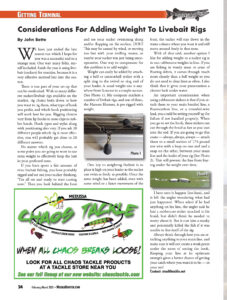Considerations For Adding Weight To Livebait Rigs
MHM Feb/March 2021 (Page 24) We have just ended the late season run which I hope for you was a successful end to a strange year. One way many folks, myself included, finish the year is using livebait (suckers) for muskies, because it is a very effective method late into the season. There is one part of your set-up that can be overlooked. With so many different sucker/livebait rigs available on the market, rig choice boils down to how you want to rig them, what type of hook you prefer, and which hook positioning will work best for you. Rigging choices vary from lip hooks to nose clips to rubber bands. Hook types and styles along with positioning also vary. If you ask 20 different people which rig is most effective, you will probably get close to 20 different answers. No matter which rig you choose, at
some point you are going to want to use extra weight to effectively keep the bait in your preferred zone. If you have spent a fair amount of time livebait fishing, you have probably rigged and set out your sucker thinking, “I’m all set and ready to start casting now.” Then you look behind the boat and see your sucker swimming along and/or flopping on the surface. DOH! This may be caused by wind, or moving too fast with your trolling motor, or maybe your sucker was just being uncooperative. One way to compensate for this problem is to add weight. Weight can easily be added by attaching a bell or cannonball sinker with a split ring to the swivel or ring end of your leader. A usual weight size is anywhere from 3⁄4-ounce to a couple ounces. (See Photo 1). My company markets a number of livebait rigs, and one of them, the Hanson Harness, is pre-rigged with weight. One key to weighting livebait is to place it high on your leader so the sucker can swim as freely as possible. Once the extra weight has been added, even with some wind or a faster movement of the boat, the sucker will stay down in the water column where you want it and still move around freely in that zone. With all that said, another option I like for adding weight to a sucker rig is to run rubbercore weights in line. If you are fishing in weedy areas or areas of floating debris, it comes through much more cleanly than a bell weight so you do not need to clear lines as often. I also think that it gives your presentation a cleaner look under water. An important consideration when
using rubbercore sinkers is that if you attach them to your main braided line, a fluorocarbon line, or a stranded-wire lead, you could be setting yourself up for failure if not handled properly. When
you go to set the hook, these sinkers can cut through the braid as fast as you lean into the rod. If you are going to go this route — always, always, always — attach them to a small section of 174-pound test wire with a loop on one end and a snap on the other, between your main line and the leader of your rig (See Photo 2). This will prevent the line from fraying under the weight over time. I have seen it happen first-hand, and it left the angler wondering what had just happened. When asked if he had anything on his line, the angler said he had a rubbercore sinker attached to his
braid, but didn’t think he needed to worry about it. But it cost him a musky and potentially killed the fish if it was unable to free itself of the rig. Always think through how you are attaching anything to your main line, and make sure it will not create a weak point under the stress of setting the hook. Keeping your line at its optimum strength gives a better chance of getting your catch where you want it to be — in your net!

